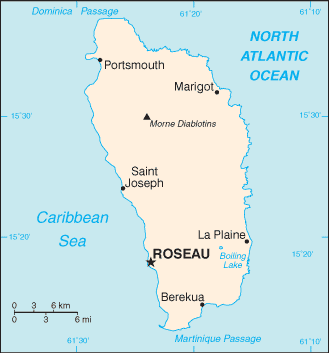America > Dominica: Weather, Map, Costs and Travel Guide

Dominica : When and where to go?
Click on a city for complete climate and weather tables
| Town | Jan | Feb | Mar | Apr | May | June | July | Aug | Sept | Oct | Nov | Dec |
| Roseau |  |  |  |  |  |  |  |  |  |  |  |  |
Dominica: Climate & Weather
The climate is tropical, with temperatures between 24 and 32 ° C, a little cooler in the mountains.
Two main seasons are distinguished: the rainy season between June and October, and the dry season from January to April. One can also speak of a hurricane season between June and September, and this month of September usually see great storms raging on the island, like the last hurricane that occurred in 1999.
The best time to visit Dominica is the dry season.
Weather today

Rain
Wind: 7 km/h
Precipitation forecast: 14,7 mm
> Full report and 7-days forecast
Data updated at 04:17 (local time)
At that time, the weather was:
 25 °C / Rain
25 °C / Rain
Dominica: Map

Sponsored links
What to do in Dominica
Then you will see Portsmouth, in its small cove, second city of the island, it also very pleasant. You will visit the Cabrits Park, divided into a marine part and a terrestrial part, and the Indian River where to take a boat trip. On the outskirts of the city, visit the stunning, quasi-deserted beaches such as Hampstead Beach and its coconut grove, or Batibou Beach, the wildest.
Continue with a visit to the Morne-Trois-Pitons National Park, which is a World Heritage Site by UNESCO, with its 7000 hectares and superb sites, dominated by the mountain that gives it its name. You will admire its valleys and volcanoes, freshwater lakes and hot springs, but also Trafalgar Falls, Bouillant Lake and Desolation Valley, and the Emerald Pool, a natural water pool Turquoise dropping 6 meters high and where you can bathe.
The Caribbean territory, to the north of the island, is made up of a group of villages inhabited by 3,500 Amerindians, who have kept their old way of life, crafts and most of their traditions. They have their own chief. You can discover their culture by visiting the Kalinago Barana Aute (Caribbean village by the sea) where cultural activities and theatrical productions are proposed.
To the southwest of Roseau, the picturesque villages succeed one another, and you will dive in Champagne, then go to Soufrière to take baths of hot mineral water and its sulphurous springs. You can also observe the sperm whales during a hike from the village of Galion.
Outdoor activities: hiking with 3000 marked trails (in particular the Waitukubuli National Trail, the longest, classified as eco-tourist site), mountain biking, kayaking, diving.
Dominica: The basics
The current currency is the Eastern Caribbean Dollar (EC $).
We landed at Canefield airport 10 minutes from Roseau, or Douglas-Charles Airport, more isolated but better served, but necessarily making a stopover in Martinique or Guadeloupe.
To get around the island there is a minibus service which criss-crosses roads in all directions, which is inexpensive, but you can also rent a car or take a public taxi, unless you prefer to do Of the stop, which is a very used way to Dominica.
Budget: the average price for accommodation is around 60 € for a double room, and you can eat a sandwich for about 3 €, while a real meal will cost between 10 and 15 €.
Health: Protect yourself from mosquitoes, and keep your vaccinations up to date.
Safety: it is better to avoid the beaches during the night, as well as to leave alone on a hiking trail. Be vigilant during your bathing, some beaches do not have a first aid station and currents can be strong. During the cyclone season, you should regularly be informed of the weather conditions during your excursions and walks. Good sun protection is required.
Shopping: you can bring baskets woven by the Kalinagos, and other straw objects like hats, bags and Creole dolls, but also rum, spices, and tobacco.



